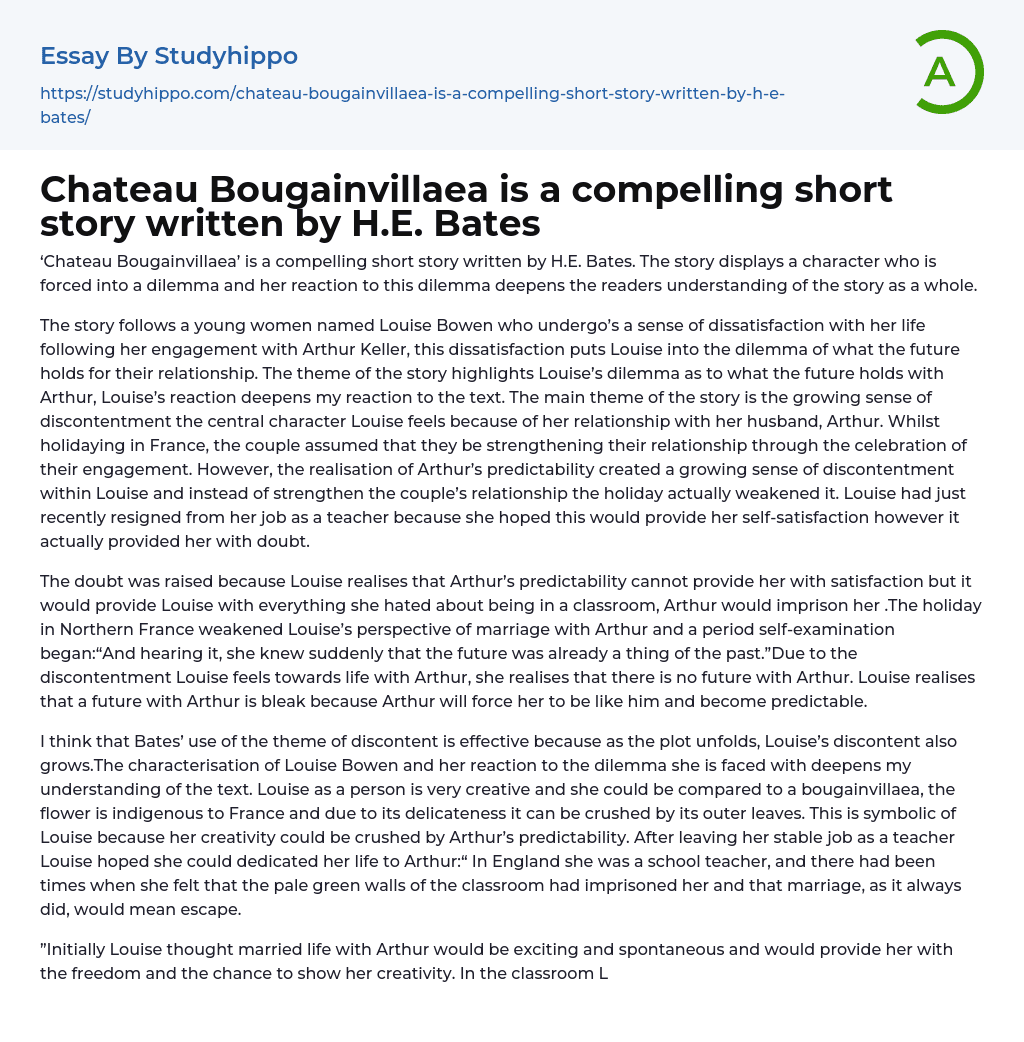

Chateau Bougainvillaea is a compelling short story written by H.E. Bates Essay Example
'Chateau Bougainvillaea', penned by H.E. Bates, is a captivating brief tale that features a character confronted with a predicament. The protagonist's response to this predicament enhances the audience's comprehension of the story at large.
The story of Louise Bowen portrays her growing sense of dissatisfaction with life after becoming engaged to Arthur Keller. This conflict leaves her unsure about the future of their relationship and creates a central theme within the story. As the story progresses, Louise's discontentment towards Arthur becomes more apparent, causing me to empathize with the character. During their trip to France, the couple had hoped that celebrating their engagement would strengthen their bond, but instead, Louise became disillusioned by Arthur's predictability. This led to a weakening of their relationship, despite the initial intentions of the trip. Additionally, Louis
...e had quit her teaching job in hopes of finding fulfillment but instead found herself plagued with doubt.
Louise doubts her relationship with Arthur because she believes he cannot fulfill her needs, but rather would constrain her to a life she despises. The couple's holiday in Northern France causes Louise to question their marriage, leading to a period of self-reflection. She comes to the realization that her future lies elsewhere, as remaining with Arthur would result in a lackluster, uninspiring existence in which she is forced to adopt his predictable lifestyle. Thus, the future she envisioned with him is already a thing of the past.
The use of the theme of discontent by Bates is effective as Louise's discontent grows along with the plot. The characterisation of Louise Bowen and her reaction to the dilemma deepens the understanding of the text. Louise, being creative, is likene
to a bougainvillaea which can be crushed by its outer leaves due to its delicateness. This is symbolic of her as Arthur's predictability could crush her creativity. Leaving her stable teaching job, Louise hoped to dedicate her life to Arthur, as she felt imprisoned by the pale green walls of the classroom and saw marriage as an escape.
"At first, Louise was under the impression that being married to Arthur would bring excitement and spontaneity, providing her with the opportunity to express her creativity freely. Due to the limitations and rules of her classroom, she was unable to fully show her creative side and she considered marriage as an escape from those restrictions. Louise felt stifled by the "pale green walls" that seemed to imprison her. However, as she began to discover Arthur's imperfections, her feelings of discontent grew stronger. She felt just as trapped in her relationship as she did in her classroom because Arthur's predictable nature lacked creativity and excitement."
The author effectively characterizes Louise, highlighting her growing sense of discontent. Bates also characterizes Arthur Keller, revealing the reason for Louise's dilemma. Although Arthur is predictable, he is oblivious to this flaw and its impact on Louise's discontent. When Arthur reveals his predictable nature, Louise becomes more frustrated. The author provides insight into Arthur's predictability at the restaurant when he finds the setting of the knives humorous, causing Louise even more frustration.
Arthur's partner is consistently annoyed because Arthur repeatedly utters a specific phrase such as "are you okay? Are you content?" This repetition coincides with Arthur's work as a draper's assistant, as his profession is symbolic of his predictable nature. Every length of cloth possesses
a quantifiable value, which aligns with Arthur's philosophy that everything in life should have worth. Arthur's daily responsibilities solely involve the measurement of fabric, which could plausibly contribute to his predictability.
The way in which Bates has employed the setting throughout the story is to bring attention to Louise and the dilemma she is facing with Arthur, whilst concurrently emphasising the different elements of her emotional state. One such example is his use of high temperatures as symbolism for Louise's growing discontentment, featuring descriptors such as "fierce heat" and "small restless flames". Additionally, Bates exploits the heat but this time in a "dry" sense, to reflect on the absence of contentment. The author also accentuates Louise's seclusion by referring to the mainland as an "island", singularly standing, devoid of protection from the harsh sun. The lack of protection is exposed through the writer's use of "brittled heather" and highlighting how the tide is completely out.
Bates demonstrates his writing capabilities by depicting the tedious afternoons in France, which leads Louise to confront her unhappiness with Arthur. The setting effectively generates doubt in Louise's mind, posing a dilemma that ultimately adds depth to the overall narrative of 'Chateau Bougainvillaea.'
The author's utilization of the theme of discontent, characterization of Louise and Arthur, as well as the setting, enhances our comprehension of the novel.
- Where Are You Going Where Have You Been essays
- Aesthetics essays
- Art History essays
- Artist essays
- ballet essays
- Body Art essays
- Color essays
- Concert Review essays
- Creativity essays
- Cultural Anthropology essays
- Ethnography essays
- Harlem Renaissance essays
- Heritage essays
- Modernism essays
- Mona Lisa essays
- Pastoral essays
- Postmodernism essays
- Realism essays
- Symbolism essays
- Theatre essays
- Visual Arts essays
- Voice essays
- Work of art essays
- Allegory essays
- Alliteration essays
- Comedy essays
- Comic book essays
- Drama essays
- Dystopia essays
- Fairy Tale essays
- Fantasy essays
- Fiction essays
- Ghost essays
- Gothic Fiction essays
- Gothic Literature essays
- Irony essays
- Legend essays
- Memoir essays
- Novel essays
- Poetry essays
- Satire essays
- Science Fiction essays
- Short Story essays
- The western essays
- Tragedy essays
- Witchcraft essays



